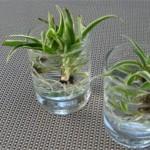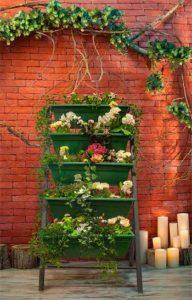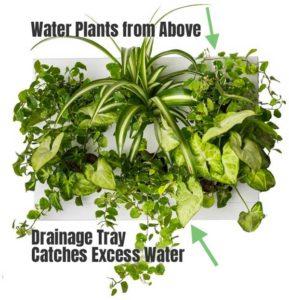Vertical gardens can be grown indoors, but special attention need to be paid to lighting, drainage and plant type. The happier your plants are and the less work you have to do to maintain them, the better your garden will look.
 Besides just looking nice, many plants can provide health benefits when grown indoors. Houseplants such as golden pothos, dracaena, spider plants, English ivy and philodendron can help filter out toxins from the air, especially when there are electronics like computers or televisions. Since vertical wall gardens can contain many plants, the health benefit is even greater than with a single potted plant.
Besides just looking nice, many plants can provide health benefits when grown indoors. Houseplants such as golden pothos, dracaena, spider plants, English ivy and philodendron can help filter out toxins from the air, especially when there are electronics like computers or televisions. Since vertical wall gardens can contain many plants, the health benefit is even greater than with a single potted plant.
Making Sure Your Houseplants Get Enough Light:
Even shade-loving plants need light, so don’t plan on growing your garden in a closet. Think about locations near windows, skylights or large, open rooms that receive a good amount of light throughout the day. You may be able to brighten up a wall by placing a mirror strategically to reflect more light to the area where you would like to place your plants.
Preventing Drainage Problems:
The last thing you need is for your walls or floors to become soaked with water. An inexpensive garden can become an expensive mess if you’re not careful.
 Many vertical garden kits include a waterproof membrane or waterproof panels along the back and sides of the structure to prevent water leaks. Additionally, most planting containers are designed with a slight sloping angle to prevent water from leaking out of the front of the garden. Some freestanding vertical planters work well too.
Many vertical garden kits include a waterproof membrane or waterproof panels along the back and sides of the structure to prevent water leaks. Additionally, most planting containers are designed with a slight sloping angle to prevent water from leaking out of the front of the garden. Some freestanding vertical planters work well too.
Some DIY Vertical Garden Tips:
This can also be done with waterproof PVC sheets as the backing and felt pockets attached to the the PVC sheets. A water collection system designed like a trough or gutter can collect excess water. I have also used a waterproofed piece of plywood with a plastic liner sheet to line the bed interior.
As the plants grow to fill the empty spaces of soil and cover the structure walls, they conveniently conceal the container itself. This way, you don’t have to worry about the actual look of the container, because it will be covered in plants anyway.
Here is a video showing the construction of a basic framed indoor garden with the pocket-style design and a hydroponic water pump:
Using the right materials for your planter structure is important, but you can also make this project easier by using drought tolerant plants that don’t require much water – like some succulents. Furthermore, smaller containers can be easily removed from the wall and laid flat for watering, making it easier to keep the wall dry.
Using the Right Plant Type for Your Vertical Garden:
 An easy first step to finding the right plant type for your indoor vertical garden is to shop for houseplants that are best grown indoors. Many plants can be grown from a vertical structure just as they grow from a traditional pot.
An easy first step to finding the right plant type for your indoor vertical garden is to shop for houseplants that are best grown indoors. Many plants can be grown from a vertical structure just as they grow from a traditional pot.
Even though you have lots of options, you want to consider the water needs of the plants you use. Choose varieties that have similar needs, since you don’t want to end up overwatering some while you are under-watering others.
The main thing you want to watch out for are plants that may grow too large for the vertical planter. They can get too heavy, and their root systems will usually require more space than the vertical container can provide.
